In Chongqing, the youngest municipality full of vitality and opportunities, three engineering universities stand out like three sharp swords in the realm of higher education. They are referred to as the “Three Engineering Swordsmen”: Chongqing University of Posts and Telecommunications, Chongqing Jiaotong University, and Chongqing University of Technology. The intriguing phrase “3G chips, sand turns to soil, and Western weapons” seems to conceal their unique disciplinary charm and development trajectories. So, in this fierce competition, who holds the greater advantage?
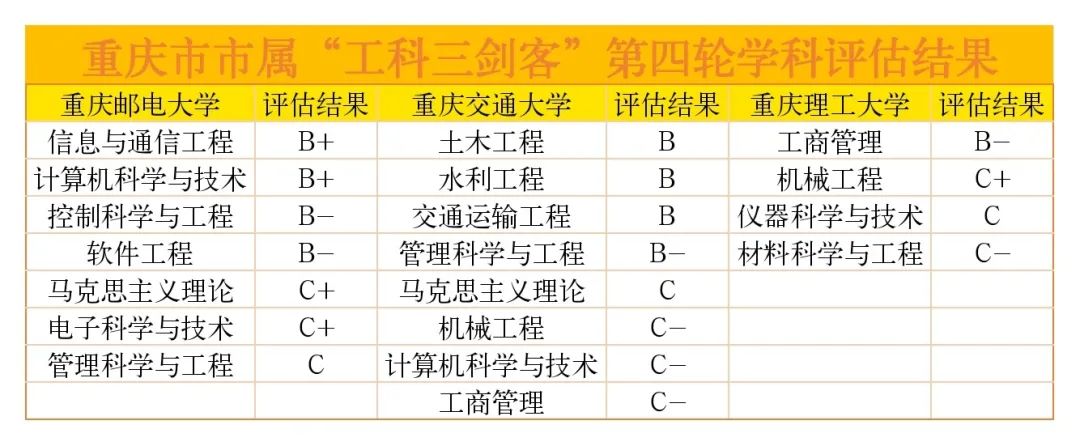
1. Chongqing University of Posts and Telecommunications: The Communication Pioneer Shining with “3G Chips” Chongqing University of Posts and Telecommunications boasts exceptional strength in the field of communication, shining brightly like the “3G chips” it has developed amidst the wave of information technology. According to discipline assessment results, it has excelled in the field of Information and Communication Engineering, receiving a B+ rating. The university has a strong research team dedicated to the development and innovation of communication technology, achieving a series of significant results in mobile communication and communication networks. In terms of discipline construction, Chongqing University of Posts and Telecommunications has built a comprehensive discipline system centered around Information and Communication Engineering. Disciplines such as Computer Science and Technology, Control Science and Engineering, and Software Engineering support each other, forming a robust disciplinary ecosystem.
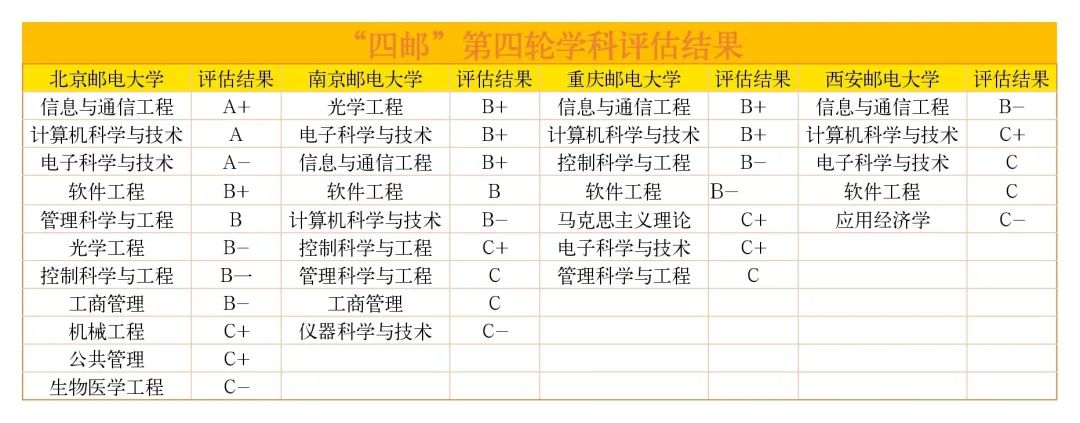
The Information and Communication Engineering discipline has over 70 years of accumulation, being one of the first in China to conduct research in digital communication and third-generation mobile communication. It has established eight provincial and ministerial key laboratories and engineering research centers, including the National Local Joint Engineering Research Center for Mobile Communication Terminals and Network Control, the Ministry of Education’s Engineering Research Center for Mobile Communication, and the Collaborative Innovation Center for New Generation Information Networks and Terminals. Achievements such as the “TD-SCDMA terminal core chip” and “communication network testing and optimization” have won four national technology invention awards and national science and technology progress awards, along with over 40 provincial and ministerial science and technology awards. The university’s two major disciplines, “Engineering” and “Computer Science,” both rank in the top 1% globally in the ESI rankings.
The Computer Science discipline relies on high-level research platforms such as the “Big Data Intelligent Computing” demonstration international science and technology cooperation base, the Ministry of Education’s key laboratory for “Cyber Space Big Data Intelligent Security,” and the “Cultural and Tourism Ministry’s Key Laboratory for Multi-source Data Perception and Decision Technology.” It has gathered innovative research teams in multi-granularity cognitive computing theory and applications, big data intelligent computing, image cognition, intelligent information processing, network security and control, and mobile internet big data. In recent years, it has led over 100 national-level research projects, more than 200 provincial and ministerial research projects, and over 300 various horizontal projects, accumulating research funding exceeding 150 million yuan. It has received over 20 national and provincial science and technology awards, including the Wu Wenjun Artificial Intelligence Science and Technology Progress Award, Chongqing Natural Science First Prize, and Science and Technology Progress First Prize. In January 2020, the Computer Science discipline entered the top 1% of the ESI international discipline rankings, with a ranking of 1.506‰ in March 2025.
The Control Science and Engineering discipline, in line with the “networked” communication gene of postal and telecommunications universities, has gradually formed a distinct “networked and intelligent” disciplinary specialty, particularly in the advantageous directions of industrial internet and intelligent manufacturing, autonomous driving and intelligent connected vehicles, and autonomous intelligence and collaborative control, which have reached a domestic first-class level. It has distinctive features in research directions such as intelligent robots, smart grids, smart education, smart energy, and smart ecology. The university has established high-level research platforms such as the China-South Korea Industrial Internet “Belt and Road” Joint Laboratory, the National Local Joint Engineering Laboratory for Networked Technology of Intelligent Instruments, and the Ministry of Education’s key laboratory for Industrial Internet and Networked Control, with annual research funding exceeding 40 million yuan. It developed the world’s first core chip for the industrial internet—Yuxin No. 1 (Tengfei); the “Xingzhe No. 1” robot set a Guinness World Record.
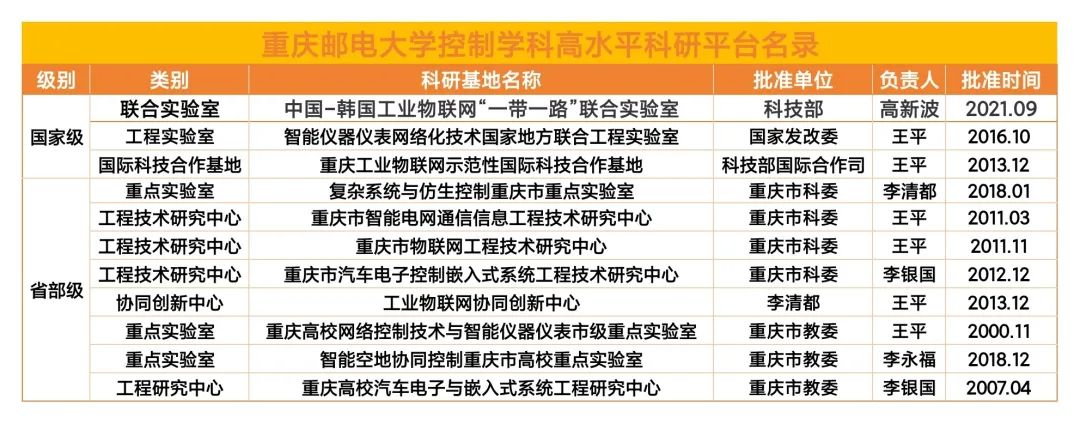 Software Engineering is based on the university’s strengths in information and communication disciplines and is the first “demonstration software college” in Chongqing, focusing on emerging industries such as cloud computing, the Internet of Things, big data, and artificial intelligence, aiming to develop new engineering education with an “engineering and international” goal, continuously enhancing and broadening educational and research capabilities. It has formed distinct educational characteristics and outstanding advantages in fields such as communication software, software testing, digital media technology, and financial technology, serving as a talent training base for software in Chongqing, a top ten service outsourcing talent training base in Chongqing, and an outstanding institution recognized by the China Software Industry Association for promoting the development of software and service outsourcing in China.
Software Engineering is based on the university’s strengths in information and communication disciplines and is the first “demonstration software college” in Chongqing, focusing on emerging industries such as cloud computing, the Internet of Things, big data, and artificial intelligence, aiming to develop new engineering education with an “engineering and international” goal, continuously enhancing and broadening educational and research capabilities. It has formed distinct educational characteristics and outstanding advantages in fields such as communication software, software testing, digital media technology, and financial technology, serving as a talent training base for software in Chongqing, a top ten service outsourcing talent training base in Chongqing, and an outstanding institution recognized by the China Software Industry Association for promoting the development of software and service outsourcing in China.
2. Chongqing Jiaotong University: “Sand Turns to Soil” Showcasing Strength in Civil and Hydraulic Engineering
Do you know about the “Desert Cherry Tomato”? The mechanics team of the School of Civil Engineering at Chongqing Jiaotong University has tackled the topic of “sand turns to soil,” and the school has a profound foundation in the “road, bridge, and water” transportation field. The results of the “Fourth Round Discipline Assessment” show that its civil engineering discipline is rated B, with hydraulic engineering and transportation engineering also rated B. This indicates that the school has strong capabilities in these three disciplines.
 The civil engineering discipline is characterized by mountain bridge and tunnel engineering, with coordinated development in structural, geotechnical, and disaster prevention and reduction directions, serving as an important platform for technological innovation in mountain bridge and tunnel engineering in China. It has four national-level platforms, including the National Key Laboratory for Mountain Bridge and Tunnel Engineering, and over ten provincial and ministerial platforms, having independently developed a world-leading structural environment/load coupling experimental platform (all-weather environmental box 32×4×3/10m, 1200t random fatigue load), an internationally advanced comprehensive experimental platform for intelligent construction and maintenance of super-large arch bridges, and a domestically leading three-dimensional model experimental platform for tunnels and underground structures. The discipline conducts in-depth research on design theories and construction technologies for large-span arch bridges, fully prefabricated bridges, and long and difficult tunnel designs, focusing on the unique geographical and climatic conditions of mountainous areas. It has led or participated in the key technological breakthroughs for about 60% of major bridge and tunnel engineering construction in the western mountainous areas, supporting the construction and operation of 16 world-class bridge and tunnel projects, with achievements winning ten national science and technology progress awards.
The civil engineering discipline is characterized by mountain bridge and tunnel engineering, with coordinated development in structural, geotechnical, and disaster prevention and reduction directions, serving as an important platform for technological innovation in mountain bridge and tunnel engineering in China. It has four national-level platforms, including the National Key Laboratory for Mountain Bridge and Tunnel Engineering, and over ten provincial and ministerial platforms, having independently developed a world-leading structural environment/load coupling experimental platform (all-weather environmental box 32×4×3/10m, 1200t random fatigue load), an internationally advanced comprehensive experimental platform for intelligent construction and maintenance of super-large arch bridges, and a domestically leading three-dimensional model experimental platform for tunnels and underground structures. The discipline conducts in-depth research on design theories and construction technologies for large-span arch bridges, fully prefabricated bridges, and long and difficult tunnel designs, focusing on the unique geographical and climatic conditions of mountainous areas. It has led or participated in the key technological breakthroughs for about 60% of major bridge and tunnel engineering construction in the western mountainous areas, supporting the construction and operation of 16 world-class bridge and tunnel projects, with achievements winning ten national science and technology progress awards.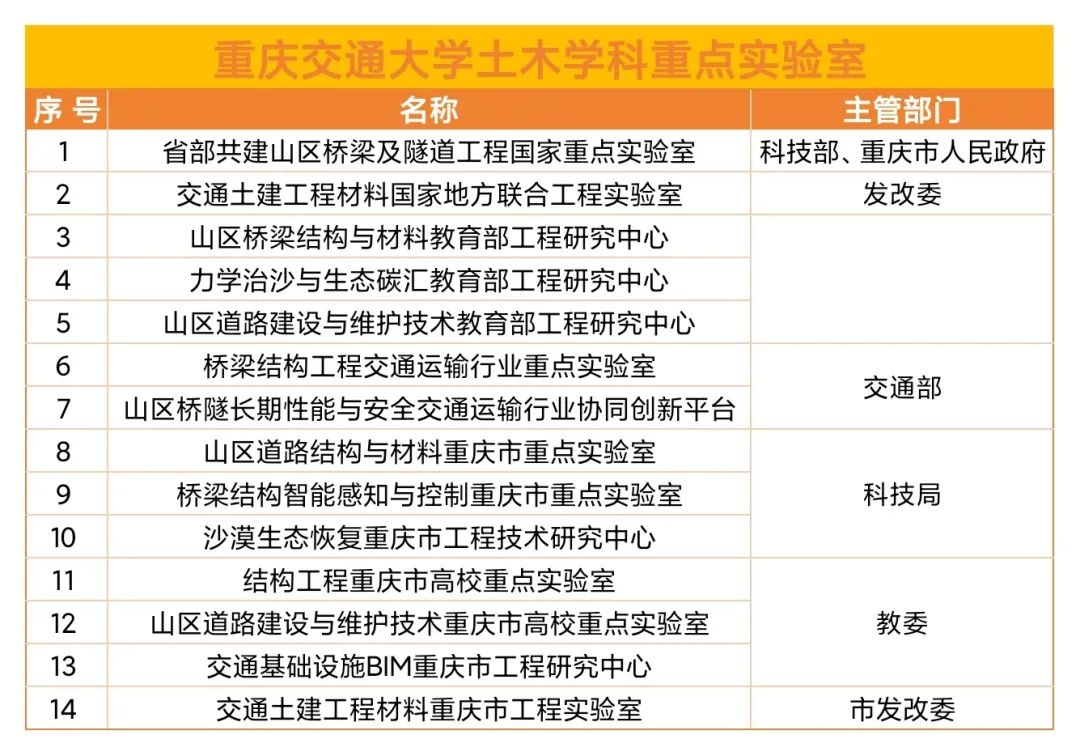 The hydraulic engineering discipline is the main technical research and talent training base for major hydraulic and water transport engineering construction in Southwest China, with nearly ten national-level talents, and has established national research platforms such as the National Research Center for Inland River Channel Regulation Engineering Technology and the Collaborative Innovation Center for Yangtze River Shipping Engineering and Intelligent Channel Technology co-built by the Ministry of Science and Technology, the Ministry of Education, and the Ministry of Transport. It continuously tackles challenges in areas such as ecological smart channels, smart port construction and hub navigation, geological disasters in transportation under extreme weather, prevention of water disasters in giant mountainous cities, and transportation environmental protection and carbon reduction, forming distinctive features and advantageous directions for the discipline, effectively supporting major national hydraulic engineering projects such as the Three Gorges Project, the Yangtze River Golden Waterway, the Pinglu Canal, and the high-grade navigation of the Xijiang River. Recently, the “Chongqing Jiaotong University Mountain Port Channel Construction and Maintenance Technology and Material Innovation Team” won the 2024 Dayu Water Conservancy Science and Technology Award Innovation Team Award, achieving a historic breakthrough for the university in this award.
The hydraulic engineering discipline is the main technical research and talent training base for major hydraulic and water transport engineering construction in Southwest China, with nearly ten national-level talents, and has established national research platforms such as the National Research Center for Inland River Channel Regulation Engineering Technology and the Collaborative Innovation Center for Yangtze River Shipping Engineering and Intelligent Channel Technology co-built by the Ministry of Science and Technology, the Ministry of Education, and the Ministry of Transport. It continuously tackles challenges in areas such as ecological smart channels, smart port construction and hub navigation, geological disasters in transportation under extreme weather, prevention of water disasters in giant mountainous cities, and transportation environmental protection and carbon reduction, forming distinctive features and advantageous directions for the discipline, effectively supporting major national hydraulic engineering projects such as the Three Gorges Project, the Yangtze River Golden Waterway, the Pinglu Canal, and the high-grade navigation of the Xijiang River. Recently, the “Chongqing Jiaotong University Mountain Port Channel Construction and Maintenance Technology and Material Innovation Team” won the 2024 Dayu Water Conservancy Science and Technology Award Innovation Team Award, achieving a historic breakthrough for the university in this award.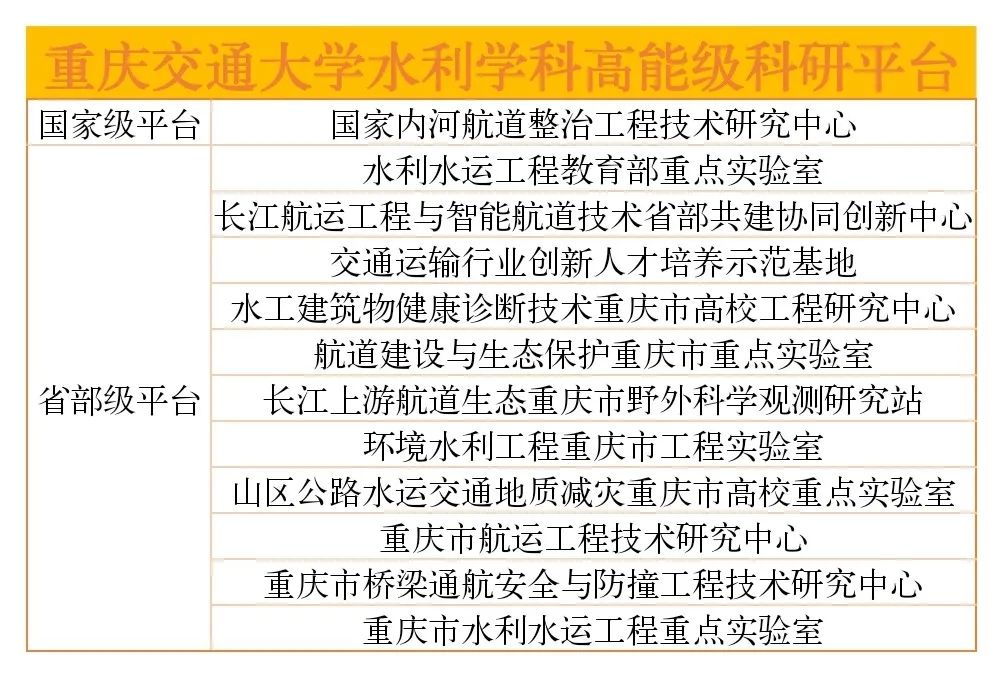 The transportation engineering discipline has five national and provincial platforms, including the “National Local Joint Engineering Laboratory for Transportation Civil Engineering Materials” and the “Ministry of Education Engineering Research Center”; it possesses advanced instruments and equipment worth about 60 million yuan for the full-environment straight-line accelerated loading testing system. It has formed characteristics and advantages in areas such as mountainous road routes and safety, road surface damage mechanisms and structural design theories, roadbed structural design theories and disaster prevention and reduction technologies, high-performance road construction material modification mechanisms and development, high slope treatment, and construction technology and disaster prevention for roads in the Three Gorges Reservoir area, as well as new materials and structures for functional pavements, solving a series of technical challenges in mountainous road construction, with many achievements incorporated into relevant regulations and standards.
The transportation engineering discipline has five national and provincial platforms, including the “National Local Joint Engineering Laboratory for Transportation Civil Engineering Materials” and the “Ministry of Education Engineering Research Center”; it possesses advanced instruments and equipment worth about 60 million yuan for the full-environment straight-line accelerated loading testing system. It has formed characteristics and advantages in areas such as mountainous road routes and safety, road surface damage mechanisms and structural design theories, roadbed structural design theories and disaster prevention and reduction technologies, high-performance road construction material modification mechanisms and development, high slope treatment, and construction technology and disaster prevention for roads in the Three Gorges Reservoir area, as well as new materials and structures for functional pavements, solving a series of technical challenges in mountainous road construction, with many achievements incorporated into relevant regulations and standards.
Additionally, there is a vehicle engineering discipline with distinctive features, focusing on intelligent, safe, and green transportation equipment, forming four advantageous research directions: transportation equipment design theories and methods, intelligent connected new energy vehicle technology, intelligent operation and maintenance of transportation engineering, and advanced manufacturing technology for transportation equipment. It has achieved a number of nationally recognized and influential research results in areas such as monorail vehicles, intelligent transportation monitoring technologies and equipment, and vehicle-road collaboration and intelligent connected driving in mountainous cities.
The school relies on its advantageous disciplines to actively serve the “Belt and Road Initiative,” the strong transportation nation strategy, the Yangtze River Economic Belt, the Chengdu-Chongqing Economic Circle, and the new western land-sea corridor, achieving a number of influential results in areas such as mountainous transportation infrastructure, cold region frozen soil engineering, ecological channels, rail equipment, transportation logistics, and green aviation. Standing at a new historical starting point, it strives to build a growing, distinctive, high-level university, contributing to the modernization of China and the construction of a modern Chongqing.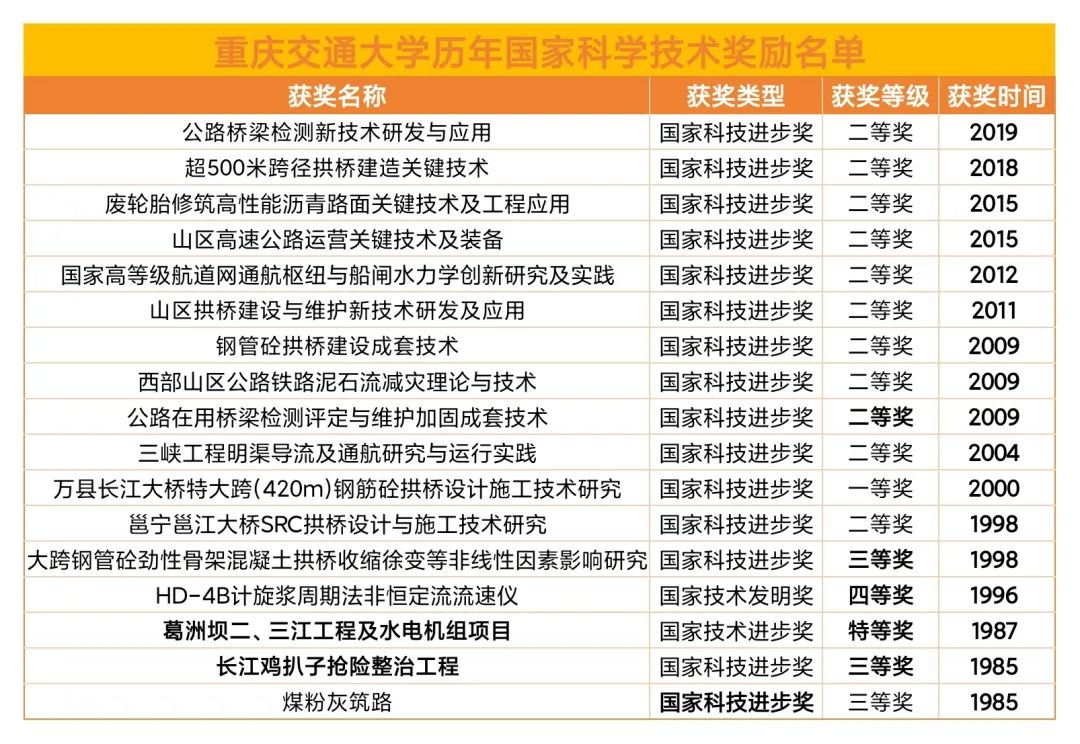 3. Chongqing University of Technology: The Mechanical Charm Behind “Western Weapons” Chongqing University of Technology originated from the 11th Technical School of the Military Commission of the National Government (known externally as Shijigong School). The school was born out of the war and thrived due to military engineering, being one of the renowned “Seven Military Engineering Universities” in China. It is now a key construction university in Chongqing and a high-level new engineering construction university, also the only ordinary undergraduate university in Southwest China with a military engineering background (referred to as “Western Weapons”). The university has distinct advantages in mechanical engineering (especially vehicle engineering), instrument science and technology, and materials science and engineering. The mechanical engineering discipline of Chongqing University of Technology received a C+ rating in the fourth round of discipline assessment. Although the rating is not top-tier, the discipline has a deep historical accumulation and unique advantages due to its military engineering background, having produced notable alumni such as Chen Jin, the chief designer of the Lynx armored vehicle, and Zheng Xuyang, the chief designer of the anti-armor vehicle. It has several provincial and ministerial-level disciplinary platforms, including the Ministry of Education’s Key Laboratory for Advanced Manufacturing Technology of Automotive Components, the International Joint Laboratory for Intelligent Manufacturing and Control of Key Components for Energy-saving and New Energy Vehicles, and the Engineering Research Center for Mechanical Detection Technology and Equipment. In energy-saving, new energy, and intelligent vehicle testing technologies, automotive active and passive safety, vehicle aerodynamics, advanced power system matching and control, energy-saving and new energy power system development, precision mechanical measurement theories and methods, and intelligent manufacturing of complex surfaces, the discipline has formed significant characteristics and outstanding advantages. Among them, it has overcome key technologies for motorcycle development, automotive automatic transmission research, and testing technologies and equipment for automotive transmission systems, strongly supporting the construction and development of Chongqing’s trillion-level automotive and motorcycle industry cluster; the invented nano-time grid displacement sensing technology and adaptive manufacturing technology for complex surface parts have reached international advanced levels; the developed CNC belt grinding machine for aircraft engine blades has been successfully applied in major aircraft engine manufacturers and has been included in the “Top 100 Industrial Mother Machines” published by the Ministry of Industry and Information Technology, receiving special coverage from CCTV. The instrument science and technology discipline collaborates deeply with the information and communication engineering and electrical engineering disciplines, establishing high-level research platforms such as the Chongqing Key Laboratory for Modern Optoelectronic Detection Technology and Instruments, the Chongqing Key Laboratory for Fiber Optic Sensing and Optoelectronic Detection, and the Chongqing Engineering Research Center for Intelligent Fiber Sensing Technology. It conducts research in numerous fields, including wireless sensor networks, broadband communication, multimedia and image processing, signal processing, intelligent analysis and diagnosis of information, modern optoelectronic detection technology and intelligent sensors, electric power electronic control technology in new energy vehicles and new energy power generation, and various signal and characteristic parameter acquisition/state recording/data processing analysis/feature extraction/characterization and recognition of electrical equipment, as well as online monitoring technology for the state of electrical equipment with multiple information. and has achieved fruitful research results.
3. Chongqing University of Technology: The Mechanical Charm Behind “Western Weapons” Chongqing University of Technology originated from the 11th Technical School of the Military Commission of the National Government (known externally as Shijigong School). The school was born out of the war and thrived due to military engineering, being one of the renowned “Seven Military Engineering Universities” in China. It is now a key construction university in Chongqing and a high-level new engineering construction university, also the only ordinary undergraduate university in Southwest China with a military engineering background (referred to as “Western Weapons”). The university has distinct advantages in mechanical engineering (especially vehicle engineering), instrument science and technology, and materials science and engineering. The mechanical engineering discipline of Chongqing University of Technology received a C+ rating in the fourth round of discipline assessment. Although the rating is not top-tier, the discipline has a deep historical accumulation and unique advantages due to its military engineering background, having produced notable alumni such as Chen Jin, the chief designer of the Lynx armored vehicle, and Zheng Xuyang, the chief designer of the anti-armor vehicle. It has several provincial and ministerial-level disciplinary platforms, including the Ministry of Education’s Key Laboratory for Advanced Manufacturing Technology of Automotive Components, the International Joint Laboratory for Intelligent Manufacturing and Control of Key Components for Energy-saving and New Energy Vehicles, and the Engineering Research Center for Mechanical Detection Technology and Equipment. In energy-saving, new energy, and intelligent vehicle testing technologies, automotive active and passive safety, vehicle aerodynamics, advanced power system matching and control, energy-saving and new energy power system development, precision mechanical measurement theories and methods, and intelligent manufacturing of complex surfaces, the discipline has formed significant characteristics and outstanding advantages. Among them, it has overcome key technologies for motorcycle development, automotive automatic transmission research, and testing technologies and equipment for automotive transmission systems, strongly supporting the construction and development of Chongqing’s trillion-level automotive and motorcycle industry cluster; the invented nano-time grid displacement sensing technology and adaptive manufacturing technology for complex surface parts have reached international advanced levels; the developed CNC belt grinding machine for aircraft engine blades has been successfully applied in major aircraft engine manufacturers and has been included in the “Top 100 Industrial Mother Machines” published by the Ministry of Industry and Information Technology, receiving special coverage from CCTV. The instrument science and technology discipline collaborates deeply with the information and communication engineering and electrical engineering disciplines, establishing high-level research platforms such as the Chongqing Key Laboratory for Modern Optoelectronic Detection Technology and Instruments, the Chongqing Key Laboratory for Fiber Optic Sensing and Optoelectronic Detection, and the Chongqing Engineering Research Center for Intelligent Fiber Sensing Technology. It conducts research in numerous fields, including wireless sensor networks, broadband communication, multimedia and image processing, signal processing, intelligent analysis and diagnosis of information, modern optoelectronic detection technology and intelligent sensors, electric power electronic control technology in new energy vehicles and new energy power generation, and various signal and characteristic parameter acquisition/state recording/data processing analysis/feature extraction/characterization and recognition of electrical equipment, as well as online monitoring technology for the state of electrical equipment with multiple information. and has achieved fruitful research results. The materials science and engineering discipline is a “first-class discipline” project in Chongqing, a key discipline in the “13th Five-Year Plan” and “14th Five-Year Plan,” establishing key laboratories for automotive component manufacturing and testing technology, the National Magnesium Alloy Engineering Technology Research Center’s Surface Engineering Sub-center, the Chongqing Collaborative Innovation Center for Precision Forming Manufacturing, the Chongqing Key Laboratory for Mould Technology, and the Chongqing Mould Engineering Technology Research Center. It has formed characteristics and advantages in high-performance metal structural materials, high-performance polymer optoelectronic functional materials, advanced electronic functional materials, advanced precision forming technologies and applications, metal corrosion protection and surface engineering, and modern connection materials and preparation technologies, entering the top 1% of the global ESI rankings in materials science in 2022.
The materials science and engineering discipline is a “first-class discipline” project in Chongqing, a key discipline in the “13th Five-Year Plan” and “14th Five-Year Plan,” establishing key laboratories for automotive component manufacturing and testing technology, the National Magnesium Alloy Engineering Technology Research Center’s Surface Engineering Sub-center, the Chongqing Collaborative Innovation Center for Precision Forming Manufacturing, the Chongqing Key Laboratory for Mould Technology, and the Chongqing Mould Engineering Technology Research Center. It has formed characteristics and advantages in high-performance metal structural materials, high-performance polymer optoelectronic functional materials, advanced electronic functional materials, advanced precision forming technologies and applications, metal corrosion protection and surface engineering, and modern connection materials and preparation technologies, entering the top 1% of the global ESI rankings in materials science in 2022.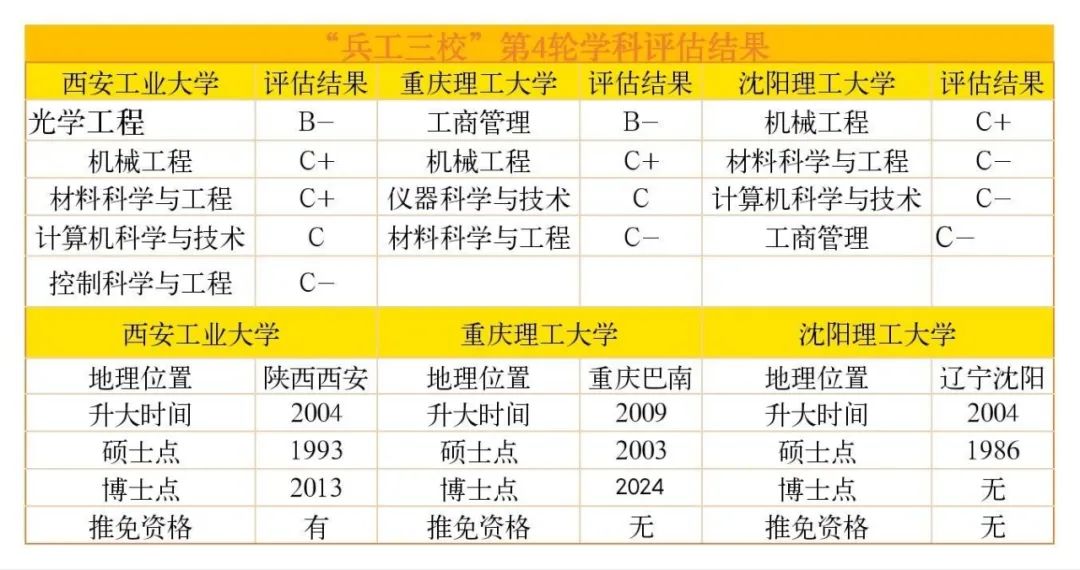 In the field of defense industry, the related universities known as the “Seven Military Engineering Universities” have developed different development trends over time. Among them, Beijing Institute of Technology and Nanjing University of Science and Technology are leading among many universities as “Double First-Class” universities; Changchun University of Science and Technology and North University are in the middle position; while Chongqing University of Technology, Xi’an University of Technology, and Shenyang University of Technology are striving to catch up from behind.
In the field of defense industry, the related universities known as the “Seven Military Engineering Universities” have developed different development trends over time. Among them, Beijing Institute of Technology and Nanjing University of Science and Technology are leading among many universities as “Double First-Class” universities; Changchun University of Science and Technology and North University are in the middle position; while Chongqing University of Technology, Xi’an University of Technology, and Shenyang University of Technology are striving to catch up from behind.
Specifically, Xi’an University of Technology started early in terms of doctoral programs and has qualifications for recommendation for graduate studies; Chongqing University of Technology has a relatively high priority in the region and just obtained doctoral programs in 2024; although Shenyang University of Technology started early, it currently does not have doctoral programs, but it has one project for cultivating doctoral talents to meet national special needs, gathering five advantageous disciplinary directions in networked ammunition efficient destruction and effectiveness assessment, networked ammunition detection and guidance control, networked ammunition communication and information processing, and ammunition materials and engineering technology, and precision processing technology. Overall—it’s all very hardcore!
4. Who Will Prevail? Overall, the “Three Engineering Swordsmen” each have their strengths, excelling in different disciplinary fields. Chongqing University of Posts and Telecommunications, with its leading advantage in communication, occupies a place in the information technology era; Chongqing Jiaotong University, relying on its traditional strengths in civil and hydraulic engineering, has supplied a large number of talents for national infrastructure construction; Chongqing University of Technology, based on its military engineering characteristics, showcases unique charm in mechanical engineering and other fields. (Chongqing University of Posts and Telecommunications and Chongqing Jiaotong University have similar educational foundations; previously, Chongqing Jiaotong University was considered superior, but now Chongqing University of Posts and Telecommunications has surpassed it. The so-called gap between these two schools is largely determined by the times, as the times create heroes. Chongqing University of Technology has a slightly weaker educational foundation but has its unique track, and its strengths align smoothly with the pillar industries of Chongqing.) As the times evolve and social demands change, each university is continuously adjusting and optimizing its disciplinary layout, strengthening interdisciplinary integration. Chongqing University of Posts and Telecommunications may further expand in emerging information technology fields; Chongqing Jiaotong University may achieve new breakthroughs in green transportation and smart water conservancy; Chongqing University of Technology will also increase its research and development efforts in intelligent manufacturing and new materials. They compete and promote each other, jointly driving the vigorous development of engineering education in Chongqing. In the future, the “Three Engineering Swordsmen” will continue to forge ahead in their respective fields, writing their own glorious chapters, and who will stand out in this long race remains to be seen. (There is also a new rising star—Chongqing University of Science and Technology, which is rapidly growing…)